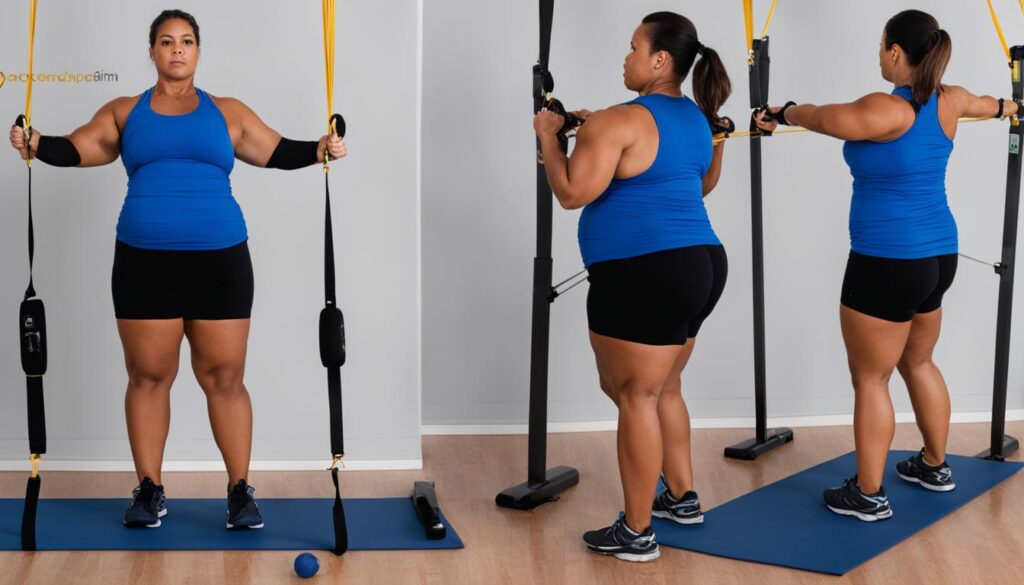As a fitness enthusiast, I understand the challenges that overweight individuals face when starting a strength training journey. However, I want to assure you that safe and effective strength training is possible regardless of your weight or fitness level. In this guide, I will share valuable tips and insights to help you embark on a safe strength training program.
Strength training is a crucial component of any fitness routine, especially for beginners. It not only helps you burn calories but also strengthens your muscles and joints. For overweight individuals, starting with low-impact exercises using only your body weight as resistance is highly recommended. This approach protects your joints and minimizes the risk of injury, allowing you to focus on building strength.
To get the most out of your strength training program, it’s essential to combine it with a calorie deficit macro-friendly diet. This will help you lose weight more effectively while ensuring you have enough energy to power through your workouts. Remember, the more you weigh, the more calories you burn during bodyweight strength training, leading to greater weight loss.
Key Takeaways:
- Strength training is beneficial for overweight beginners, promoting weight loss and overall health.
- Start with low-impact exercises using your body weight as resistance to minimize the risk of injury.
- Combine strength training with a calorie deficit macro-friendly diet for optimal results.
- Consult with a healthcare professional and fitness trainer to create a personalized plan tailored to your needs.
- Consistency is key – aim for 2-3 strength training sessions per week for at least 20-30 minutes each.
Benefits of Strength Training for Overweight Beginners
Strength training has numerous benefits for individuals who are overweight and new to exercise. Incorporating strength training into your fitness routine can lead to long-term results, improved body composition, and overall health. Let’s explore the various advantages of strength training for overweight individuals.
1. Weight Loss and Calorie Burning
Strength training helps promote weight loss by burning calories. When you engage in strength training exercises, your muscles use energy and calories to perform the movements. Over time, this can lead to a reduction in body weight and fat mass. Strength training also boosts your metabolism, allowing you to burn more calories throughout the day.
2. Muscle Building and Increased Strength
Strength training not only burns calories but also helps build muscle mass. By lifting weights or using resistance, you stimulate your muscles to grow and become stronger. This increase in muscle mass improves your overall strength, making daily activities easier to perform. Increased strength also contributes to better posture and balance, reducing the risk of falls and injuries.
3. Joint Health and Injury Prevention
Contrary to popular belief, strength training done with proper form and technique can be beneficial for joint health. The controlled movements and strengthening of muscles surrounding the joints can help improve their stability and reduce the risk of joint-related issues. Strength training can also enhance bone density, reducing the risk of osteoporosis and fractures.
4. Body Composition and Toning
Strength training helps improve body composition by reducing body fat and increasing lean muscle mass. This results in a more toned and sculpted physique. While losing weight alone can result in a reduction in muscle mass, strength training helps preserve and build muscle, leading to a more aesthetically pleasing body shape.
5. Long-Term Results and Sustainability
One of the key benefits of strength training is its long-term effectiveness. Unlike crash diets or excessive cardio, which can lead to muscle loss and metabolic slowdown, strength training offers sustainable results. As you continue to strength train and build muscle, your metabolism remains elevated, helping you maintain a healthy weight and body composition in the long run.
“Strength training not only helps with weight loss but also improves joint health and increases overall strength and muscle tone. Incorporating strength training into your fitness routine can have lasting benefits for overweight individuals looking to improve their health and well-being.”
| Benefits of Strength Training for Overweight Beginners |
|---|
| Weight loss and calorie burning |
| Muscle building and increased strength |
| Joint health and injury prevention |
| Body composition and toning |
| Long-term results and sustainability |
Strength training is a powerful tool for individuals starting their fitness journey, particularly those who are overweight. By incorporating strength training into their workout routines, overweight beginners can experience a wide range of benefits, from weight loss and increased muscle mass to improved joint health and long-term sustainability. Whether your goal is to lose weight, improve overall fitness, or enhance your body composition, strength training is an essential component of a comprehensive fitness program.
How to Gauge Exercise Intensity and Frequency

When starting a strength training program, it’s important to gauge exercise intensity and frequency. This will ensure that you are pushing yourself enough to see progress, but not overexerting yourself and risking injury. Here are some key factors to consider:
Gauging Exercise Intensity
Exercise intensity refers to how hard you are working during your workouts. One way to measure this is by using the Rate of Perceived Exertion (RPE) scale. The RPE scale assigns a number from 1 to 10, with 1 being very low intensity and 10 being maximum effort. As a beginner, aim for a 5 or 6 intensity level, where you feel like you’re working moderately hard. Gradually increase this to a 7 or 8 as your body adapts and becomes stronger. This will help you challenge yourself and continue to see progress.
Determining Exercise Frequency
Exercise frequency refers to how often you should be working out. Consistency is key when it comes to strength training. For beginners, aim to exercise 2-3 times per week. This allows your body enough time to recover and adapt to the new demands you’re placing on it. Each session should last for at least 20-30 minutes to provide sufficient stimulus for your muscles to grow stronger. Remember, quality trumps quantity when it comes to strength training. It’s better to have shorter, focused workouts than longer, less-intense sessions.
By carefully gauging exercise intensity and frequency, you can ensure that your strength training program is both effective and safe. Remember to listen to your body and make adjustments as needed. And always consult with a qualified fitness professional if you have any concerns or questions.
Low-Impact Exercises for Overweight Beginners
When it comes to starting a fitness journey as an overweight beginner, incorporating low-impact exercises is key. These exercises are gentle on the joints and provide a great starting point for building strength and improving overall movement. Here are some low-impact exercises that are perfect for overweight beginners:
- Walking: Walking is a simple yet effective low-impact exercise that can be done anywhere. It helps to increase cardiovascular endurance and burn calories without putting excessive stress on the joints. Start with shorter walks and gradually increase your pace and duration as you become more comfortable.
- Swimming: Swimming is a fantastic low-impact exercise that engages the entire body. It provides resistance without bearing weight on the joints, making it ideal for overweight individuals. Whether you’re swimming laps or participating in a water aerobics class, swimming can help improve strength and cardiovascular fitness.
- Cycling: Cycling, whether outdoors or on a stationary bike, is another low-impact exercise that can be easily modified to suit your fitness level. It helps to strengthen the legs, improve cardiovascular endurance, and burn calories. Start with shorter cycling sessions and gradually increase the duration and intensity.
- Using Stairs: Incorporating stairs into your workout routine is an excellent way to improve cardiovascular fitness and strengthen the lower body. Start with a few flights of stairs and gradually increase the number of flights and your pace. If you have knee or joint issues, be sure to take it at a comfortable pace and listen to your body.
In addition to these low-impact exercises, incorporating bodyweight exercises can help improve overall strength and movement. Bodyweight exercises utilize your own body weight as resistance, making them accessible and effective for overweight beginners. Here are some low-impact bodyweight exercises to try:
- Planks: Planks are a great exercise for strengthening the core. Start with shorter holds and gradually increase the duration as your core gets stronger. Remember to engage your core and maintain proper form throughout the exercise.
- Hinges: Hinges, also known as hip hinges or deadlift variations, target the muscles in the lower back, glutes, and hamstrings. They help to improve hip mobility and strengthen the posterior chain. Focus on maintaining a neutral spine and hinging at the hips while keeping your knees slightly bent.
- Wall Sits: Wall sits are a challenging exercise for the legs that can be done using only a wall for support. They target the quadriceps and glutes, helping to build strength and endurance. Start with shorter holds and gradually increase the duration as your leg muscles get stronger.
- Wall Push-Ups: Wall push-ups are a modified version of traditional push-ups that can help build upper body strength. Stand facing a wall and place your hands on the wall at shoulder height. Bend your elbows and lower your body towards the wall, then push back up to the starting position. Adjust the angle of your body to increase or decrease the difficulty of the exercise.
- Superman Holds: Superman holds are a great exercise for targeting the muscles in the lower back. Lie face down on the floor with your arms extended overhead and your legs straight. Lift your arms, chest, and legs off the floor, engaging your lower back muscles. Hold this position for a few seconds and then lower back down. Repeat for several reps.
By incorporating these low-impact exercises and bodyweight movements into your fitness routine, you can build strength, improve mobility, and work towards your fitness goals. Remember to always listen to your body, start at a comfortable level, and gradually increase the intensity and duration of your workouts.
Modified Exercises for Overweight Beginners

Overweight beginners can modify common strength training exercises to suit their abilities. It’s important to choose exercises that can be performed correctly and gradually increase the number of reps as strength improves. Here are some modifications and progressions to consider:
1. Planks:
Planks can be done on the knees or as an incline plank against a wall. Start by holding the position for a comfortable amount of time and gradually increase the duration as your core strength improves.
2. Squats:
Modify squats by using a chair or wall for support. Stand in front of a chair or place your back against a wall, then lower yourself down as if you were sitting back onto the chair or into a seated position against the wall. Focus on maintaining proper form and gradually increase the depth of the squat as you gain strength.
3. Lying Glute Bridges:
Start by performing lying glute bridges with shorter holds and gradually progress to longer holds. You can also use a stability ball or a step bench to elevate your feet, increasing the difficulty of the exercise as you become stronger.
4. Push-ups:
If full push-ups are challenging, start with kneeling push-ups. Focus on maintaining a straight line from your knees to your shoulders. As your upper body strength increases, progress to full-range push-ups on your toes.
Remember, everyone starts somewhere, and modifications are a normal part of any fitness journey. Listen to your body, choose exercises that feel challenging but not overwhelming, and gradually progress as you gain strength and confidence.
Importance of Diet for Overweight Beginners
While strength training is beneficial for weight loss and overall health, diet also plays a crucial role in achieving optimal results. Maintaining a healthy caloric deficit and following a macro-friendly diet can support fat loss and improve lean body mass.
When it comes to weight loss, creating a calorie deficit is essential. This means consuming fewer calories than your body needs to maintain its current weight. By doing so, your body taps into its stored fat reserves for energy, leading to fat loss over time.
A macro-friendly diet focuses on consuming the right balance of macronutrients – proteins, carbohydrates, and fats – to support your fitness goals. These macronutrients provide essential nutrients, energy, and help you feel satisfied after meals.
Protein is particularly important during weight loss, as it helps preserve muscle mass, supports muscle repair, and aids in satiety. Incorporate lean sources of protein such as chicken, fish, tofu, and legumes into your meals.
Carbohydrates provide energy for your workouts and daily activities. Choose complex carbohydrates like whole grains, fruits, and vegetables, which provide essential fiber and nutrients.
Fats are important for hormone production, vitamin absorption, and overall health. Opt for healthy fats such as avocados, nuts, seeds, and olive oil.
Remember, it’s not about completely eliminating any food group or depriving yourself. It’s about finding a sustainable and balanced approach that you can maintain in the long run.
In addition to a calorie deficit and macro-friendly diet, it’s important to focus on improving body composition. Losing fat while preserving or increasing lean muscle mass can significantly improve your overall body composition and metabolic health.
By combining strength training with a well-rounded diet, you can achieve the best results in terms of fat loss, muscle strength, and overall fitness. It’s important to find a balance between exercise and nutrition to achieve long-term success in managing weight and improving body composition.
Conclusion
Safe strength training for overweight beginners is a highly beneficial fitness journey that can lead to significant improvements in weight loss, strength, and overall health. The key is to start with low-impact exercises and gradually increase intensity and frequency over time. By incorporating a balanced diet, individuals on their fitness journey can optimize their results and achieve long-term success.
When starting strength training, it’s crucial to consult with a healthcare professional and fitness trainer to create a personalized plan that considers individual abilities and ensures safe and effective progress (check out my post on starting strength training here). They can provide guidance on proper form, exercise modifications, and the appropriate intensity and frequency for workouts.
Throughout the fitness journey, it’s important to remember that consistency is key. By committing to regular strength training sessions, individuals can experience the benefits of increased muscle mass, improved body composition, and enhanced joint health. These notable outcomes contribute to a healthier and more active lifestyle.
In summary, Safe Strength Training for Overweight Beginners offers tremendous benefits for those seeking to improve their weight loss and overall fitness goals. With proper planning, guidance, and determination, individuals can embark on a successful fitness journey that promotes both physical and mental well-being.




